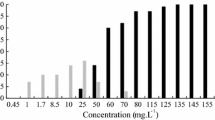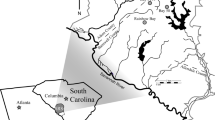Abstract
Epidalea calamita embryos at Gosner stages 3 and 19, and larvae at Gosner stage 25, were exposed to different copper sulfate concentrations, ranging from 0.05 to 0.40 mg Cu L−1, in 96-h acute toxicity tests. Embryonic and larval mortality, development, growth, and larval escape behavior were evaluated. LC50 at 96 h obtained at Gosner stages 3, 19, and 25 were 0.22, 0.08, and 0.11 mg Cu L−1, respectively. Embryonic and larval developments were delayed after 96 h of copper sulfate exposure. Growth was also affected and individuals in control treatments grew to twice the size of those exposed to copper concentrations over 0.2 mg Cu L−1 during the experiments initiated at Gosner stage 19. Escape behavior was altered after 96 h of copper sulfate exposure; larvae showed shorter distances moved and abnormal displacement types. However, after 4 days of recovery process, most of the larvae showed normal escape behavior. For amphibians that develop in temporary wetlands, increased development time, lower size, and altered escape behavior might have repercussions on the number of individuals that can successfully complete metamorphosis and, consequently, on recruitment.






Similar content being viewed by others
References
Abel PD, Axiak V (1991) Ecotoxicology and the marine environment. Ellis Horwood, New York
Álvarez J, Salvador A, López P, Martin J (1991) Desarrollo larvario de la rana común (Rana perezi) (Anura:Ranidae) en charcas temporales del noroeste de la península Ibérica. Doñana Act Vertebr 18:123–132
Armengol J, Sabater F, Sabater S (1993) Variaciones en la carga de nutrientes en la cuenca del río Ter y su efecto sobre las comunidades de indicadores biológicos. Junta de Sanejament del Departament de Medi Ambient de la Generalitat de Catalunya. Universitat de Barcelona, Barcelona, Spain
Blaustein L, Schwartz SS (2001) Why study ecology in temporary pools? Isr J Zool 47:303–312. doi:10.1560/CKMU-Q2PM-HTGC-P9C8
Blaustein AR, Romansic JM, Kiesecker JM, Hatch AC (2003) Ultraviolet radiation, toxic chemicals and amphibian population declines. Diversity Distrib 9:123–140. doi:10.1046/j.1472-4642.2003.00015.x
Bosch J (2003) Nuevas amenazas para los anfibios: enfermedades emergentes la conservación de los anfibios en Europa. Munibe 16:56–73
Breden F, Kelly CH (1982) The effect of conspecific interaction on metamorphosis in Bufo americanus. Ecology 63:1682–1689. doi:10.2307/1940110
Bridges CM (1997) Tadpole swimming performance and activity affected by acute exposure to sublethal levels of carbaryl. Environ Toxicol Chem 16:1935–1939. doi :10.1897/1551-5028(1997)016<1935:TSPAAA>2.3.CO;2
Bridges CM (2000) Long-term effects of pesticide exposure at various life stages of the southern leopard frog (Rana sphenocephala). Arch Environ Contam Toxicol 39:91–96. doi:10.1007/s002440010084
Bridges CM, Boone MD (2003) The interactive effects of UV-B and insecticide exposure on tadpole survival, growth and development. Biol Conserv 113:49–54. doi:10.1016/S0006-3207(02)00348-8
Bridges CM, Semlitsch RD (2000) Variation in pesticide tolerance of tadpoles among and within species of Ranidae and patterns of amphibian decline. Conserv Biol 14:1490–1499. doi:10.1046/j.1523-1739.2000.99343.x
Bridges CM, Dwyer FJ, Hardesty DK, Whites DW (2002) Comparative contaminant toxicity: are amphibian larvae more sensitive than fish? Bull Environ Contam Toxicol 69:562–569. doi:10.1007/s00128-002-0098-2
Casado S, Montes C (1995) Guía de los lagos y humedales de España. In: Reyero JM (ed), Madrid Spain
Chen TH, Gross JA, Karasov WH (2007) Adverse effects of chronic copper exposure in larval northern leopard frogs (Rana pipiens). Environ Toxicol Chem 26:1470–1475
Cooke AS (1973) The effects of DDT, when used as a mosquito larvicide, on tadpoles of the frog Rana temporaria. Environ Pollut 5:259–273. doi:10.1016/0013-9327(73)90003-7
Cooke AS (1977) Effects of field applications of the herbicides diquat and dichlobenil on amphibians. Environ Pollut 12:43–50. doi:10.1016/0013-9327(77)90006-4
Davidson C (2004) Declining downwind: amphibian population declines in California and historical pesticide use. Ecol Appl 14:1892–1902. doi:10.1890/03-5224
De Liñán C (1997) Farmacología vegetal. Agrotécnicas, Madrid
Diana SG, Resetarits WJ, Schaeffer DJ, Beckmen KB, Beasley VR (2000) Effects of atrazine on amphibian growth and survival in artificial aquatic communities. Environ Toxicol Chem 19:2961–2967. doi :10.1897/1551-5028(2000)019<2961:EOAOAG>2.0.CO;2
Fleeger JW, Carman KR, Nisbet RM (2003) Indirect effects of contaminants in aquatic ecosystems. Sci Total Environ 317:207–233. doi:10.1016/S0048-9697(03)00141-4
Gosner KL (1960) A simplified table for stating anuran embryos and larvae with notes on identification. Herpetologica 16:183–190
Greulich K, Pflugmache S (2003) Differences in susceptibility of various life stages of amphibians to pesticide exposure. Aquat Toxicol 65:329–336. doi:10.1016/S0166-445X(03)00153-X
Griffiths RA (1997) Temporary ponds as amphibian habitats. Aquat Conserv Mar Freshwat Ecosyst 7:119–126. doi :10.1002/(SICI)1099-0755(199706)7:2<119::AID-AQC223>3.0.CO;2-4
Guerrero F, Parra G, Jiménez-Gómez F, Salazar C, Jiménez-Melero R, Galotti A, García-Muñoz E, Lendínez ML, Ortega F (2006) Ecological studies in Alto Guadalquivir wetlands: a first step towards the application of conservation plans. Limnetica 25:95–106
Hall LW Jr, Scott MC, Killen WD (1998) Ecological risk assessment of copper and cadmium in surface waters of Chesapeake Bay watershed. Environ Toxicol Chem 17:1172–1189. doi :10.1897/1551-5028(1998)017<1172:ERAOCA>2.3.CO;2
Herkovits J, Pérez-Colla C, Herkovits FD (2002) Ecotoxicological studies of environmental samples from Buenos Aires area using a standardized amphibian embryo toxicity test (AMPHITOX). Environ Pollut 116:177–183. doi:10.1016/S0269-7491(01)00167-1
Junta de Andalucía (2008) Reglamento específico de producción integrada de olivar. BOJA 83:9–38. http://www.juntadeandalucia.es/bojas/
Khangarot BS, Battish SK (1994) Experimental studies on the acute toxicity of copper to Daphnia lumholtzi (Sars). Indian J Ecol 11:183–185
Landé SP, Guttman SI (1973) The effects of copper sulphate on the growth and mortality rate of Rana pipiens tadpoles. Herpetologica 29:22–27
Linder G, Grillitsch B (2000) Ecotoxicology of metals. In: Sparling DW, Linder G, Bishop CA (eds) Ecotoxicology of amphibians and reptiles. SETAC Press, Pensacola, FL, pp 325–408
Marcial HS, Hagiwara A, Snell TW (2005) Effect of some pesticides on reproduction of rotifer Brachionus plicatilis Müller. Hydrobiologia 546:569–575. doi:10.1007/s10750-005-4302-3
Marco A (2002) Contaminación global por nitrógeno y declive de anfibios. Rev Esp Herpetol 16:5–17
Marco A (2003) Impacto de la radiación ultravioleta y contaminación en anfibios la conservación de los anfibios en Europa. Munibe 16:44–45
Marco A, Blaustein AR (1999) The effects of nitrite on behavior and metamorphosis in cascades frogs (Rana cascadae). Environ Toxicol Chem 18:946–949. doi :10.1897/1551-5028(1999)018<0946:TEONOB>2.3.CO;2
Marco A, Cash D, Belden LK, Blaustein AR (2001) Sensitivity to urea fertilization in three amphibian species. Arch Environ Contam Toxicol 40:406–409. doi:10.1007/s002440010190
Marquis O, Millery A, Guittonneau S, Miaud C (2006) Toxicity of PAHs and jelly protection of eggs in the common frog Rana temporaria. Amphibia-Reptilia 27:472–475. doi:10.1163/156853806778189945
McDiarmid RW, Mitchell JC (2000) Diversity and distribution of amphibians and reptiles. In: Sparling DW, Linder G, Bishop CA (eds) Ecotoxicology of amphibians and reptiles. SETAC Press, Pensacola, FL, pp 15–69
Mendiguchía C (2005) Utilización de ultratrazas de metales pesados como trazadores de los efectos antropogénicos producidos en ecosistemas acuáticos. PhD dissertation. Universidad de Cádiz, Cádiz, Spain
MMA (2000) Libro Blanco del Agua. Ministerio de Medio Ambiente, Madrid
Murphy JE, Phillips CA, Beasley VR (2000) Aspects of amphibian ecology. In: Sparling DW, Linder G, Bishop CA (eds) Ecotoxicology of amphibians and reptiles. SETAC Press, Pensacola, FL, pp 141–178
Parra G, Jiménez-Melero R, Guerrero F (2005) Agricultural impacts on mediterranean wetlands: the effect of pesticides on survival and hatching rates in copepods. Ann Limnol-Int J Lim 41:161–167
Pérez-Coll CS, Herkovits J (2006) Synergistic effects of copper and butylic ester of 2, 4-dichlorophenoxyacetic acid (Esternon Ultra) on amphibian embryos. Int J Environ Res Public Health 3:343–347
Pollet I, Bendell-Young LI (2000) Amphibians as indicators of wetland quality in wetlands formed from oil sands eVuent. Environ Toxicol Chem 19:2589–2597. doi :10.1897/1551-5028(2000)019<2589:AAIOWQ>2.3.CO;2
Prosser L (1991) Environmental and metabolic animal physiology. Wiley Liss, New York
Rand GM, Wells PG, McCarty LS (1995) Introduction to aquatic toxicology. In: Rand GM (ed) Fundamentals of aquatic toxicology: effects environmental fate and risk assessment. Taylor & Francis, Washington, DC, pp 3–66
Räsänen K, Pahkala M, Laurila A, Merilä J (2003) Does jelly envelope protect the common frog Rana temporaria embryos from UV-B radiation? Herpetologica 59:293–300
Relyea RA (2005) The lethal impacts of roundup and predatory stress on six species of north American tadpoles. Arch Environ Contam Toxicol 48:351–357. doi:10.1007/s00244-004-0086-0
Rowe CL (1998) Elevated standard metabolic rate in a freshwater shrimp (Palaemonetes paludosus) exposed to trace element-rich coal combustion waste. Comp Biochem Physiol Part A Mol 121:299–304
Rowe CL, Hopkins WA, Coffman VR (2001) Failed recruitment of southern toads (Bufo terrestris) in a trace element-contaminated breeding habitat: direct and indirect effects that may lead to a local population sink. Arch Environ Contam Toxicol 40:399–405. doi:10.1007/s002440010189
Rowe CL, Hopkins WA, Congdon JD (2002) Ecotoxicological implications of aquatic disposal of coal combustion residues. Environ Monit Assess 80:207–276. doi:10.1023/A:1021127120575
Salvador A, García-París M (2001) Anfibios españoles. Identificación, historia natural y distribución. Esfagnos, Talavera de la Reina, Spain
Schuytema GS, Nebeker AV (1999) Effects of ammonium nitrate, sodium nitrate and urea on red-legged frogs: Pacific treefrogs and African clawed frogs. Bull Environ Contam Toxicol 63:357–364. doi:10.1007/s001289900988
Semlitsch RD, Scott DE, Pechmann JHK (1988) Time and size at metamorphosis related to adult fitness in Ambystoma talpoideum. Ecology 69:184–192. doi:10.2307/1943173
Sih A, Kerby J, Bell A, Relyea R (2004) Response to Schmidt. Pesticides, mortality and population growth rate. Trends Ecol Evol 19:460–461. doi:10.1016/j.tree.2004.06.006
Sinsch U (1998) Biologie und Ökologie der Kreuzkröte. Laurenti Verlag, Bochum, Germany
Sparling DW, Bishop CA, Pauli BD, Money S (2000) Epilogue: lessons yet to be learned. In: Sparling DW, Linder G, Bishop CA (eds) Ecotoxicology of amphibians and reptiles. SETAC Press, Pensacola, FL, pp 811–822
Sparling DW, Fellers GM, McConnell LL (2001) Pesticides and amphibian population declines in California, USA. Environ Toxicol Chem 20:1591–1595. doi :10.1897/1551-5028(2001)020<1591:PAAPDI>2.0.CO;2
Sundaram KMS (1995) Distribution, persistence and fate of mexacarbate in the aquatic environment of a mixed-wood boreal forest. J Environ Sci Health Part B 30:651–683
Tejedo M (2003) El declive de los anfibios. La dificultad de separar las variaciones naturales del cambio global la conservación de los anfibios en Europa. Munibe 16:20–43
Tejedo M, Reques R (1997) Bufo calamita. In: Pleguezuelos JM (ed) Distribución y biogeografía de los anfibios y reptiles de España y Portugal. Universidad de Granada-AHE, Granada, Spain, pp 155–157
Troncoso L, Galleguillos R, Larrain A (2000) Effects of copper on the fitness of the Chilean sacllop Argopecten purpuratus (Mollusca: Bivalvia). Hydrobiologia 420:185–198. doi:10.1023/A:1003947407939
Van Dam RA, Camilleri C, Finlayson CM (1998) The potential of rapid assessment techniques as early warming indicators of wetland degradation: a review. Environ Toxicol Water Qual 13:297–312. doi :10.1002/(SICI)1098–2256(1998)13:4<297::AID-TOX3>3.0.CO;2-2
Vitt LJ, Caldwell JP, Wilbur HM, Smith DC (1990) Amphibians as harbingers of decay. Bioscience 40:418
Weis JS, Smith G, Zhou T, Santiago-Bass C, Weis P (2001) Effects of contaminants on behavior: Biochemical mechanisms and ecological consequences. Bioscience 51:209–217. doi:10.1641/0006-3568(2001)051[0209:EOCOBB]2.0.CO;2
Acknowledgments
This study was supported by the Universidad de Jaén (Project “Plan Propio 2006–2008”). Our thanks go to the Consejería de Medio Ambiente (Junta de Andalucía) for permission to take amphibian samples. We thank Dr. Tejedo and the two anonymous reviewers for their valuable comments to improve the manuscript.
Author information
Authors and Affiliations
Corresponding author
Rights and permissions
About this article
Cite this article
García-Muñoz, E., Guerrero, F. & Parra, G. Effects of Copper Sulfate on Growth, Development, and Escape Behavior in Epidalea calamita Embryos and Larvae. Arch Environ Contam Toxicol 56, 557–565 (2009). https://doi.org/10.1007/s00244-008-9201-y
Received:
Accepted:
Published:
Issue Date:
DOI: https://doi.org/10.1007/s00244-008-9201-y




